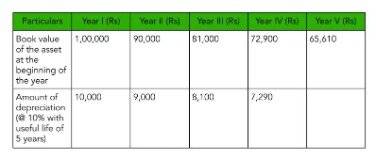
Bank Reconciliation Statement is a record book of the transactions of a bank account. This statement helps the account holders to check and keep track of their funds and update the transaction record that they have made. The balance mentioned in the bank passbook of the statement must tally with the balance mentioned in the cash book. In the statement, all the deposit will be shown in the credit column and withdrawals will be shown in the debit column. However, if the withdrawal exceeds deposit it will show a debit balance (overdraft).

Many companies produce bank reconciliation statements regularly to ensure they’ve recorded all their banking transactions properly and that their ending balance matches the amount the bank says they have. Bank statements are commonly routinely produced by the financial institution and used by account holders to perform their bank reconciliations. As mentioned above, the process of comparing your cash book details with the records of your business’ bank transactions as recorded by the bank is known as bank reconciliation. Bank reconciliation done through accounting software is easier and error-free.
To see your business as it is
Bank reconciliation statements ensure that payments were processed and cash collections were deposited into the bank. Bank reconciliation statements are often used to catch simple errors, duplications, and accidental discrepancies. Some mistakes could adversely affect financial reporting and tax reporting. The bank statement submitted by the businessman at the end of May will not contain an entry for the check, whereas the cash book will have the entry. It involves looking at your company’s books and your company’s actual bank statement and cross-checking the two records to make sure that they match. In single-entry bookkeeping, every transaction is recorded just once (rather than twice, as in double-entry bookkeeping), as either income or an expense.
The bank transactions are imported automatically allowing you to match and categorize a large number of transactions at the click of a button. For doing this, you must add deposits in transit, deduct outstanding checks and add/deduct bank errors. Similarly, when a business receives an invoice, it credits the amount of the invoice to accounts payable (on the balance sheet) and debits an expense (on the income statement) for the same amount.
How Often Should You Reconcile Your Bank Account?
Below is a video explanation of the bank reconciliation concept and procedure, as well as an example to help you have a better grasp of the calculation of cash balance. After adjusting the balances as per the bank and as per the books, the adjusted amounts should be the same. If they are still not equal, you will have to repeat the process of reconciliation again. Bank reconciliation helps to identify errors that can affect estimated tax payments and financial reporting. The reconciliation statement allows the accountant to catch these errors each month. The company can now take steps to rectify the mistakes and balance its statements.
- Using this simple process each month will help you uncover any differences between your records and what shows up on your bank statement.
- To create a bank reconciliation, you will need to gather your bank statements and reconcile them with your accounting records (ledger).
- A company prepares a bank reconciliation statement to compare the balance in its accounting records with its bank account balance.
It could be that a transaction has been carried out by an unauthorised person who is attempting to steal money from the company’s account. The sooner any missing funds can be spotted, the more quickly they can be recovered and any lasting damage can be mitigated. While there are a number of reasons for discrepancies occurring in bank reconciliation, the reason should always be identified because there is always a possibility of fraudulent activity. Bankrate follows a strict editorial policy, so you can trust that we’re putting your interests first. Our award-winning editors and reporters create honest and accurate content to help you make the right financial decisions. This practical article illustrates the key points of why a bank reconciliation is important for both business and personal reasons.
This process accurately reflects all transactions, thereby making your financial monitoring accurate and transparent. Account reconciliation is particularly useful for explaining any differences between two financial records or account balances. Some differences may be acceptable because of the timing of payments and deposits. Unexplained or mysterious discrepancies, however, may warn of fraud or cooking the books. Businesses and individuals may reconcile their records daily, monthly, quarterly, or annually. Watch this webinar to see the Chaser platform in action, or contact our team to find out how Chaser can support your business accounting processes.
How Reconciliation Works
For example, if a company writes a check that has not cleared yet, the company would be aware of the transaction before the bank is. Similarly, the bank might have received funds on the company’s behalf and recorded them in the bank’s records for the company before the organization is aware of the deposit. After adjusting the balance as per the cash book, make sure that you record all adjustments in your company’s general ledger accounts. This is done by taking into account all the transactions that have occurred until the date preceding the day on which the bank reconciliation statement is prepared. To reconcile your bank statement with your cash book, you need to ensure that the cash book is complete.
Generally, neither balance is the correct amount of cash that should be reported on the company’s balance sheet. Let’s assume that a new company opens its first checking account on June 4 with a deposit of $10,000. During the month of June the company wrote five checks pay virtually any bill with credit cards with a total of $5,000. It also made a $2,000 deposit in the bank’s night depository after banking hours on June 30. As a result, the company’s Cash account (in its general ledger and referred to as the “books”) as of June 30 shows a positive, debit balance of $7,000.
Comparing deposits during a bank reconciliation is crucial to maintain financial accuracy and prevent potential overdrawn accounts. This process helps to ensure all recorded transactions match your bank statement. After reviewing all deposits and withdrawals, adjusting the cash balance and accounting for interest and fees, your ledger’s ending balance should match the bank statement balance.
Helpful Tips for Bank Reconciliation Adjustments
At the end of this process, the adjusted bank balance should equal the company’s ending adjusted cash balance. Bank Reconciliation is the process of comparing your business’ books of accounts with your bank statements. It is done periodically to check whether the bank-related transactions are recorded properly in your books of accounts.
The bank will debit your business account only when the bank pays these issued cheques. After adjusting all the above items what you get is the adjusted balance of the cash book. As mentioned above, bank overdraft is a condition where a bank account becomes negative as a result of excess withdrawals over deposits. When completed, the reconciliation should show the correct cash balance. The bank has charged fees for its services, such as a monthly account fee. At AccountsIQ, we can help you to integrate automation into all areas of your accounting, with benefits that extend far beyond just bank reconciliation.
In this case, the reconciliation includes the deposits, withdrawals, and other activities affecting a bank account for a specific period. The need and importance of a bank reconciliation statement are due to several factors. First, bank reconciliation statements provide a mechanism of internal control over cash. When account reconciliations are incorporated into the month-end closing process, this can delay the completion of the close. Controllers can mitigate this issue by mandating that only accounts with large ending balances be reconciled at the end of each month, thereby reducing the workload while still spotting most account errors. They’re a great way to get into the mindset of your financials and find any discrepancies.
